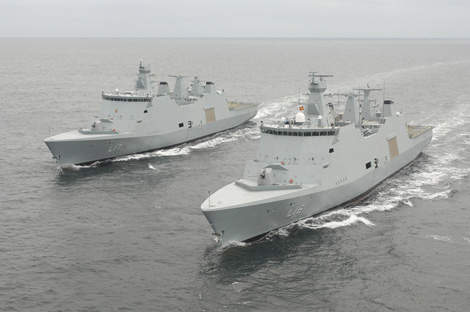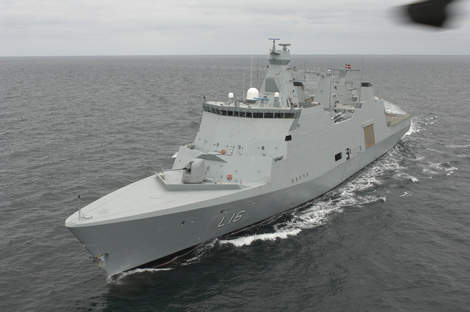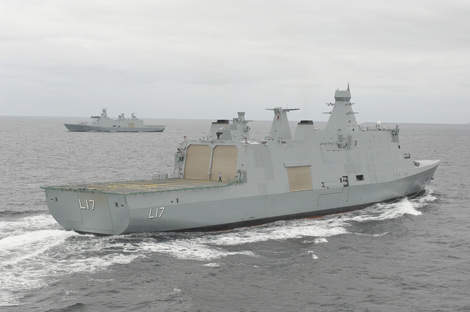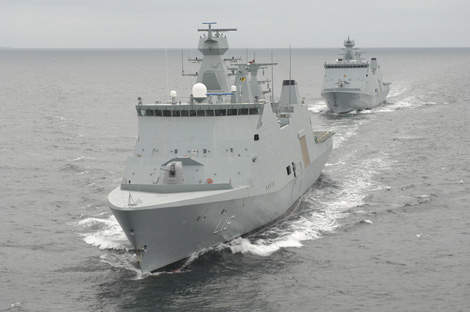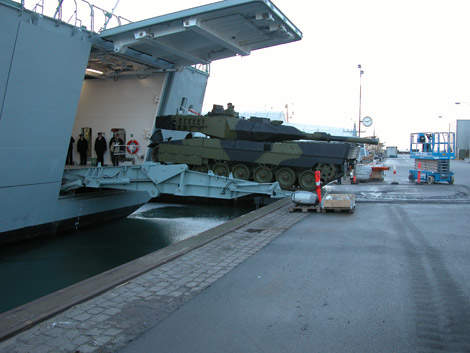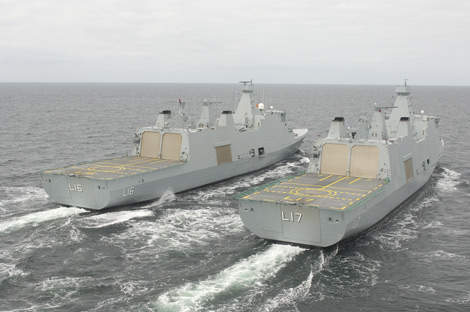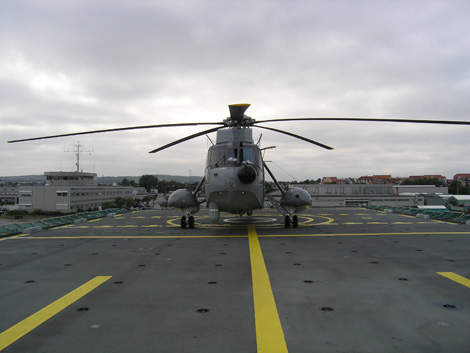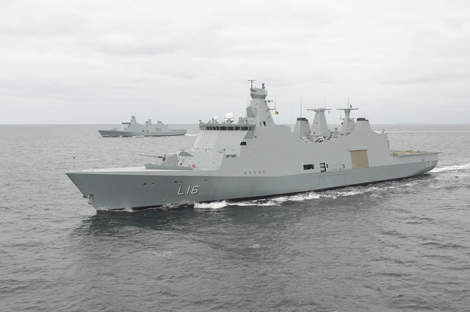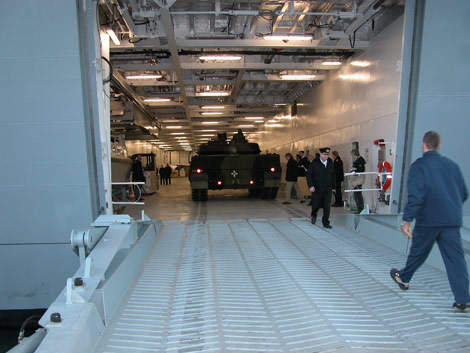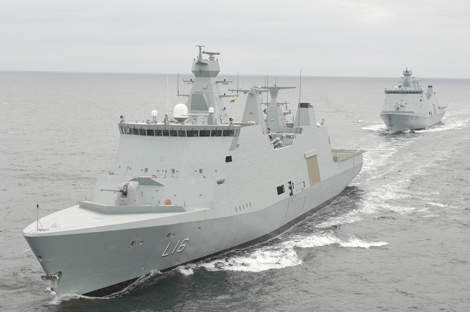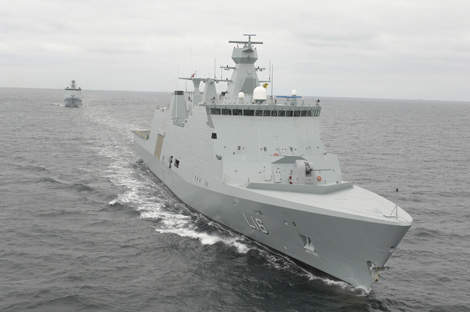The two Absalon Class vessels, built by Odense Steel Shipyard for the Danish Navy, are flexible support ships (combat support ships). The ships can be equipped for naval warfare, land attack, strategic sealift missions or as a command platform. They can also be configured as hospital ships or for emergency disaster relief.
HDMS Absalon (L16) was launched in February 2004 and commissioned into the Royal Danish Navy in July 2004. The second of class, Esbern Snare (L17), was launched in June 2004 and commissioned in February 2005.
Weapon and combat system acceptance trials concluded with a test firing of the evolved Sea Sparrow missile (ESSM) in May 2008 to be followed by entry into service by the end of 2008.
The installation and integration of the ship’s combat systems is managed by the Danish Naval Materiel Command (NMC) at the Korsoer Naval Base, except for the mk45 mod 4 gun which was installed during the construction of the ship by Odense Steel Shipyard at Lindo.
Absalon Class combat support ship design
The Absalon Class has a full load displacement of 6,300t. The hull is 137m long, has a 19.5m maximum beam and a 6.3m draught.
The ship design, with 16 watertight sections or compartments and two airtight bulkheads, incorporates survivability and damage limitation features including dual redundancy, automated damage control zones, damage detectors and smoke zones. The ship’s on-board battle damage and control system continuously monitors the status of the ship and incorporates a closed circuit television observation system with more than 50 cameras, fire fighting installations, sensors and alarms, a load and stability computer.
A roll-on roll-off ramp installed at the stern of the ship accesses the flex deck (flexible deck). The flex deck, providing 915m², and 250m of parking lanes, is about 90m long. The reinforced deck can embark vehicles up to 62t such as the Leopard II main battle tank.
The ship design incorporates stealth characteristics for low acoustic, radar, visual and infrared signatures. Shock protection and isolation are to STANAG 4142, 4137 and 4549. Parts of the hull are armour protected to STANAG 4569 standard. Manned areas are protected against nuclear biological and chemical warfare to STANAG 4447.
Command and control
The ship has a Terma C-Flex Combat management and Command, Control, Communications and Intelligence system (C4I). Systematic and Terma developed the software for the C-Flex and Maersk Data Defence was contracted for the development and supply of the hardware and system consoles.
The C-Flex system uses the T-Core common operational environment configured with a layered architecture.
The ship has over 20 multifunction consoles equipped with large screen displays and workstations. Digitised video imagery data from the radars and sensor suite is distributed on a TCP/IP network. The ship is fitted with a 1G Ethernet TCP/IP local area network for data transfer.
The communications suite includes tactical data links Link 11, Link 16, civil and military satellite communications operating in EHF, SHF and UHF bands, voice communications in VHF and UHF bands, civil and commercial communications, and video teleconferencing. Antenna stations are installed for use by army, air force or special forces.
In August 2008, Terma was awarded a contract to supply a multi-link system (MLS) which will interface to the C-Flex combat system and allow the future integration of Link 22.
Weapons
The ship has five standard flex container wells in the weapons deck in the mid section of the ship. The standard weapons container fit for the ship will be two modules for the Harpoon surface-to-surface missile and three modules for the Evolved Sea Sparrow surface-to-air missiles.
Two modules each carry eight Harpoon Block II surface-to-surface missiles.
The three modules for the surface-to-air missiles will each carry a 12-cell mk6 vertical launcher allowing the ship to carry 36 RIM-162 Raytheon Evolved Sea Sparrow Missiles (ESSM). The CEROS 200 fire control system provides radar homing illumination. The ship is fitted with four Flexfire radar and electro-optical trackers.
The ship will be armed with the Eurotorp MU 90 lightweight torpedo and a twin or triple torpedo launcher on both sides of the weapons deck.
The ship can carry up to 300 mines and can be fitted with containerised mine laying rails.
The ship has two Close-In-Weapon Systems (CIWS), the Oerlikon Contraves Millenium, 35mm naval gun system (GDM-008), one to the front of the bridge and one on the roof of the hangar. Millenium can fire the 35mm Ahead Air Burst Munition, at 1,000 rounds a minute. Each round contains 152 3.3g sub-projectiles, fired at a velocity of 1,050m/sec. Millenium is effective at over 3.5km for aircraft / helicopters, 2km for guided missiles / cruise missiles and 1.2km for anti-radiation missiles.
Under a contract awarded in October 2002, a BAE Systems Land & Armaments (formerly United Defense) 127mm 62 mk45 mod 4 gun provides naval fire support capability. The gun will be capable of firing the newly developed Extended-Range Guided Munitions (ERGM) such as the EX-171 ER which will have a range of over 100km with an accuracy of less than 20m.
Countermeasures
The ship is fitted with six Terma decoy launchers managed by a launch control computer. Four 12-barrelled Terma DL-12T 130mm launchers are installed on both sides of the bridge and the hangar. Two six-barrel DL-6T launchers are installed on the aft of the hangar.
In September 2005, EDO Corporation was awarded a contract to provide the ES 3701 tactical radar Electronic Support Measures (ESM) and surveillance system for the Absalon vessels.
Aircraft
The helicopter hangar can accommodate two EH101 helicopters. The 850m² flight deck, which is rated for take-off and landings of helicopters up to 20t such as the Boeing CH-47D Chinook, is equipped with a McTaggart Scott helicopter landing system and a Harpoon deck lock.
Elevator access is available between the flight deck and the flex deck. For non-helicopter operations the flight deck can be used for cargo containers.
Insertion craft
The ship is equipped for insertion of Special Operations Forces (SOF). The cargo deck carries two special forces insertion craft. The 7.4t 12m SRC-90E insertion craft are operated by a crew of two or three and can carry 1,800kg of equipment, up to nine passengers or four stretcher patients.
The craft are launched from the port stern by a monorail and crane system and can be launched and recovered while the ship is underway.
The Storebro Bruks SRC-90E is constructed of composite laminates using carbon fibre and vinyl ester resins. The water jet propulsion system gives a speed of over 40kt.
Sensors
The ship has a Thales Naval Netherlands SMART-S mk2 3D S-band multi-beam surveillance and target designation radar, with a range of 250km and up to 70° elevation, and a Saab Systems Ceros 200 mk3 fire control radar, operating in I to J band. The SMART-S mk2 was installed in HDMS Absalon in June 2007. The Terma Scanter 2001 X-band radar provides surface surveillance.
The navigation suite includes navigation radars operating at X and S bands, supplied by Furuno Marine. The ship’s C4I system is linked to the electronic chart display information system. The navigation data is downloaded to the OSI display information system.
The ship is fitted with an Atlas Elektronik ASO 94-01 hull-mounted sonar.
Accommodation
The Absalon class has a crew of 100. Permanent accommodation is also included for up to 70 additional personnel such as combined or joint task force headquarters staff. Container accommodation for an additional 130 forces personnel can be installed on the flex deck. The ship has galley and personnel facilities for up to 300 embarked passengers and crew.
A containerised modular hospital can be installed on the flex deck. The hospital has a throughput capacity to treat 40 emergency patients a day or up to ten major surgical operations.
Propulsion
Rockwell Automation supplied the ships’ integrated platform management system which includes the power management system. The ships are powered by two MTU 8000 diesel engines in a combined diesel and diesel configuration.
The engines are each rated at 8.31MW. The power system includes four auxiliary Caterpillar 3508B diesel engines each rated at 920kW and Van Kaick DSG 74 generators. The machinery spaces are insulated to maintain a low thermal signature and the machinery is installed on vibration isolation elastomeric mounts. Two shafts drive controllable pitch propellers.
Bow thrusters provide precision manoeuvrability for docking.
The ship has a maximum sustained speed of 23k and carries stores and fuel for a mission endurance of 28 days. The maximum range between replenishments is 9,000nm. The ship is fitted with port and starboard, receive and transfer, replenishment-at-sea stations.

